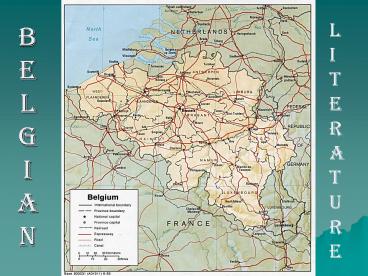B E L G I A N PowerPoint PPT Presentation
1 / 14
Title: B E L G I A N
1
BELGIAN
L I T E R A T U R E
2
Language Map of Belgium
3
Walloons
- Walloons are a group of people living in
Southern Belgium who traditionally spoke a
dialect of French called Walloon, but who today
for the most part speak standard French. The
Walloons, numbering some 3.5 million, reside
mostly in the provinces of Hainaut, Liège, Namur,
Luxembourg, and Walloon Brabant, in contrast to
the Dutch-speaking Flemings of the northern
provinces.
4
Etymology of Walloon
- a. F. Wallon (fem. Wallonne), n. and a.med.L.
Walln-em, f. Teut. walah, walh, foreigner (OE.
wealh) see WELSH a. The name represents the
appellation given by the Teut. Flemings and
Franks to their Romanic-speaking neighbours.
5
Four Major Belgian Literary Movements
- Romanticism
- Realism
- Naturalism
- Symbolism
6
Romanticism
- Romanticism stressed strong emotion,
imagination, freedom within or even from
classical notions of form in art, and overturning
of previous social conventions, particularly the
position of the aristocracy. There was a strong
element of historical and natural inevitability
in its ideas, stressing the importance of
"nature" in art and language. Romanticism is also
noted for its elevation of the achievements of
what it perceived as heroic individuals and
artists
7
Realism
- The realists sought to render everyday
characters, situations, dilemmas, and events all
in an "accurate" (or realistic) manner. Realism
began as a reaction to romanticism, in which
subjects were treated idealistically. Realists
tended to discard theatrical drama and classical
forms of art to depict commonplace or 'realistic'
themes.
8
Naturalism
- Naturalistic writers were influenced by the
evolution theory of Charles Darwin. They believed
that one's heredity and surroundings decide one's
character. Whereas realism seeks only to describe
subjects as they really are, naturalism also
attempts to determine "scientifically" the
underlying forces (i.e. the environment or
heredity) influencing these subjects' actions.
9
Symbolism
- Symbolism was in large part a reaction against
Naturalism and Realism. Symbolists believed that
art should aim to capture more absolute truths
which could only be accessed by indirect methods.
Thus, they wrote in a highly metaphorical and
suggestive manner, endowing particular images or
objects with symbolic meaning.
10
- Maurice Maeterlinck
- 18621949
- Influenced by the mystical thought of Novalis
and Emerson his eventual 60-odd volumes can be
read as a symbolist manifesto. Their suggestion
of universal mystery, their insistence on ennui
and impending doom affected the mood of a whole
generation before World War I. Maeterlinck was
awarded the 1911 Nobel Prize in Literature. His
works include the short story Le Massacre des
innocents (1886) the plays Les Aveugles (1891,
tr. The Blind), Pelléas et Mélisande (1892),
which inspired Debussy's opera (1902), Monna
Vanna (1902), and L'Oiseau bleu (1909, tr. The
Blue Bird), an allegorical fantasy for children
that denies the reality of death the essays La
Vie des abeilles (1901, tr. The Life of the Bee)
and L'Intelligence des fleurs (1907, tr. Life and
Flowers) and poems.
11
- Émile Verhaeren
- 18551916
- A Fleming who wrote in French. He had a disgust
with mankind and a passion for social reform. He
wrote naturalistic verse. A period of gloom and
melancholic unrest in which he traveled over
Western Europe and spent much time in London is
reflected in a trilogy of poetic worksLes Soirs
and Les Débâcles (both 1888), and Les Flambeaux
noirs (1891). He also wrote for his wife, Marthe
Massin, a trilogy of love poemsLes Heures
claires (1896, tr. The Sunlit Hours, 1916), Les
Heures de l'après-midi (1905, tr. Afternoon,
1917), and Les Heures du soir (1911, tr. The
Evening Hours, 1918). Outstanding among his
dramas, which combine verse and prose, is Hélène
de Sparte (1912, tr. 1916). The poems in Les
Ailes rouges de la guerre the red wings of war
(1917) are his bitter protest against war.
12
- Georges Simenon
- 19031989
- One of the most prolific of modern authors--he
was able to write 60 to 80 pages a day. He is
best known for the detective stories featuring
Inspector Maigret. He also wrote more than a
hundred psychological novels, which he called
romans durs (hard novels), such as The Stain on
the Snow (1938) and The Cat (1976).
13
- Georges Remi, a.k.a. Hergé
- 1907-1983
- Tintin is one of the most popular 20th
century European comics. Over 200 million books
have been published to date, with translations
into over 50 languages. The comic book series has
long been admired for its clean but expressive
drawings (executed in Hergé's signature ligne
claire style), engaging plots, and the
painstaking research of the later stories. The
series straddles a variety of genres
swashbuckling adventures with elements of
fantasy, mysteries, political thrillers, and
science fiction. All the titles in the Tintin
series include plenty of slapstick humour, offset
in later albums by dashes of sophisticated satire
and political/cultural commentary.
14
- Cest Fin
- Merci Beaucoup
- Madame Goudarzi et tout le monde

